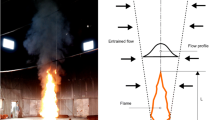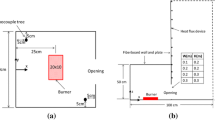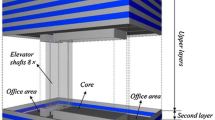Abstract
The fire service uses a number of tactics to reduce hazards for fire-fighters and civilians within a structure on fire. One offensive fire-fighting tactic that has potential for rapidly improving or degrading conditions within the structure is ventilating the structure. Positive pressure ventilation is a tactic in which a fan is used to push hot products of combustion out of a burning structure. While a recent body of work has been produced on the effects of positive pressure ventilation in a number of fire systems, there is still widespread uncertainty on how the tactic affects the fire environment. Computational tools will play an important role in exploring the impact of positive pressure ventilation in various fire scenarios. In many simulations of structure fires, the impact of leakage on the evolution of the fire is not addressed. We find in this study that ad hoc models of leakage have significant impact on the evolution of the fire. Several ad hoc leakage models are proposed and these are studied in terms of their impact of the fire. We show that one particular leakage geometry is able to best model leakage effects in a series of fire simulations that are compared to experiments. Simple, first-order analysis is used to understand how these leakage flows affect the predictions.


























Similar content being viewed by others
References
Mittendorf J (1996) Strip ventilation tactics. Fire Eng 149(3):48
Ziesler PS, Gunnerson FS, Williams SK (1994) Advances in Positive Pressure Ventilation. Fire Technology 30:269
S Svensson (2001) Experimental Study of Fire Ventilation during Fire Fighting Operations. Fire Technology 37:69–85
Svensson S (2002) A Study of Tactical Patterns during Fire Fighting Operations. Fire Safety Journal 37:673–695
Ezekoye OA, Lakshminarasimhan K, Seers P, Nicks R (2005) Effects of positive pressure ventilation on thermal conditions downstream of a fire. Fire Technol 41:193–208
Kerber S, Walton WD (2005) Effect of positive pressure ventilation on a room fire. NISTIR 7213, March 2005
Vettori RL, Madrzykowski D, Walton WD (2000) Simulation of the dynamics of a fire in a one-story restaurant, Texas, February 14. NISTIR 6923, October 2000
Sinai YL (1999) Comments on role of leakages in field modeling of under-ventilated compartment fires. Fire Safety J 33(1):11–20
McGrattan KB, Baum HR, Rehm RG, Hamins A, Forney GP, Floyd JE, Hostikka S, Prasad K (2002) Fire dynamics simulator (version 4)—technical reference guide. NISTIR 6783
McGrattan KB, Forney GP, Floyd JE, Hostikka S, Prasad K (2002) Fire dynamics simulator (version 4)—user’s guide. NISTIR 6784
Tewarson A (1995) Generation of heat and chemical compounds in fire. In: SFPE handbook of fire engineering, 2nd edn. Society of fire protection engineers, Boston, MA, pp. 3.53–3.124
Fire Experimental Results. Building and Fire Research Laboratory, available at: http://www.fire.nist.gov/fire/fires/fires.html. Retrieved June 2006
Quintiere JG (2006) Fundamentals of Fire Phenomena. John Wiley & Sons Ltd, Chichester, West Sussex, England
Author information
Authors and Affiliations
Corresponding author
Rights and permissions
About this article
Cite this article
Beal, C.M., Fakhreddine, M. & Ezekoye, O.A. Effects of Leakage in Simulations of Positive Pressure Ventilation. Fire Technol 45, 257–286 (2009). https://doi.org/10.1007/s10694-008-0055-7
Received:
Accepted:
Published:
Issue Date:
DOI: https://doi.org/10.1007/s10694-008-0055-7




